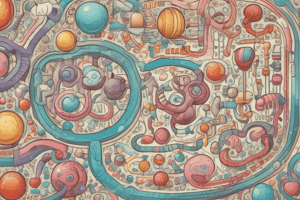Podcast
Questions and Answers
What is the primary function of amino acid degradation?
What is the primary function of amino acid degradation?
- To convert ammonia into urea
- To catalyze transamination reactions
- To synthesize new amino acids
- To break down amino acids into smaller molecules for energy production or other cellular processes (correct)
Which of the following is NOT a step in the urea cycle?
Which of the following is NOT a step in the urea cycle?
- Glutamate is converted into alpha-ketoglutarate (correct)
- Arginine is converted into ornithine and urea
- Ammonia is converted into citrulline
- Citrulline is converted into arginine
What is the product of the transamination reaction between aspartate and alpha-ketoglutarate?
What is the product of the transamination reaction between aspartate and alpha-ketoglutarate?
- Pyruvate and glutamate
- Alanine and alpha-ketoglutarate
- Citrulline and arginine
- Oxaloacetate and glutamate (correct)
Which enzyme is involved in the conversion of citrulline into arginine in the urea cycle?
Which enzyme is involved in the conversion of citrulline into arginine in the urea cycle?
What is the result of deamination of an amino acid?
What is the result of deamination of an amino acid?
Which of the following is a characteristic of transamination reactions?
Which of the following is a characteristic of transamination reactions?
What is the primary function of the urea cycle?
What is the primary function of the urea cycle?
Which of the following is an example of a transamination reaction?
Which of the following is an example of a transamination reaction?
Which enzyme is involved in the conversion of arginine into ornithine and urea in the urea cycle?
Which enzyme is involved in the conversion of arginine into ornithine and urea in the urea cycle?
What is the byproduct of the deamination reaction?
What is the byproduct of the deamination reaction?
Flashcards are hidden until you start studying
Study Notes
Amino Acid Degradation
- Amino acid degradation is the process of breaking down amino acids into smaller molecules, which can be used for energy production or other cellular processes.
- There are three main ways to degrade amino acids:
- Oxidative deamination: involves the removal of an amino group (-NH2) and the formation of an alpha-keto acid.
- Transamination: involves the transfer of an amino group to an alpha-keto acid, resulting in the formation of a new amino acid and an alpha-keto acid.
- Dehydrogenation: involves the removal of a hydrogen atom from the amino acid, resulting in the formation of an alpha-keto acid.
Urea Cycle
- The urea cycle, also known as the ornithine cycle, is a metabolic pathway that converts ammonia (NH3) into urea, which can be excreted from the body.
- The urea cycle takes place in the liver and kidney cells.
- The cycle involves the following steps:
- Ammonia (NH3) is converted into citrulline through the action of the enzyme N-acetylglutamate synthase.
- Citrulline is converted into arginine through the action of the enzyme argininosuccinate synthase.
- Arginine is converted into ornithine and urea through the action of the enzyme arginase.
- Ornithine is recycled back into citrulline through the action of the enzyme ornithine transcarbamylase.
Transamination
- Transamination is a reaction in which an amino group (-NH2) is transferred from an amino acid to an alpha-keto acid, resulting in the formation of a new amino acid and an alpha-keto acid.
- Transamination reactions are reversible and can occur in both directions.
- Transamination reactions are catalyzed by enzymes called transaminases.
- Examples of transamination reactions:
- Aspartate + alpha-ketoglutarate ⇌ oxaloacetate + glutamate
- Alanine + alpha-ketoglutarate ⇌ pyruvate + glutamate
Deamination
- Deamination is the process of removing an amino group (-NH2) from an amino acid, resulting in the formation of an alpha-keto acid.
- Deamination reactions are irreversible and can occur in the liver, kidneys, and other tissues.
- Deamination reactions are catalyzed by enzymes called deaminases.
- Examples of deamination reactions:
- Glutamate → alpha-ketoglutarate + NH3
- Aspartate → oxaloacetate + NH3
Amino Acid Degradation
- Amino acid degradation is the process of breaking down amino acids into smaller molecules, which can be used for energy production or other cellular processes.
- Three main ways to degrade amino acids: oxidative deamination, transamination, and dehydrogenation.
Urea Cycle
- The urea cycle, also known as the ornithine cycle, converts ammonia (NH3) into urea, which can be excreted from the body.
- The cycle takes place in the liver and kidney cells.
- The cycle involves four steps:
- Ammonia (NH3) is converted into citrulline.
- Citrulline is converted into arginine.
- Arginine is converted into ornithine and urea.
- Ornithine is recycled back into citrulline.
Transamination
- Transamination is a reaction in which an amino group (-NH2) is transferred from an amino acid to an alpha-keto acid.
- Transamination reactions are reversible and can occur in both directions.
- Transamination reactions are catalyzed by enzymes called transaminases.
- Examples of transamination reactions:
- Aspartate + alpha-ketoglutarate → oxaloacetate + glutamate
- Alanine + alpha-ketoglutarate → pyruvate + glutamate
Deamination
- Deamination is the process of removing an amino group (-NH2) from an amino acid, resulting in the formation of an alpha-keto acid.
- Deamination reactions are irreversible and can occur in the liver, kidneys, and other tissues.
- Deamination reactions are catalyzed by enzymes called deaminases.
- Examples of deamination reactions:
- Glutamate → alpha-ketoglutarate + NH3
- Aspartate → oxaloacetate + NH3
Studying That Suits You
Use AI to generate personalized quizzes and flashcards to suit your learning preferences.



